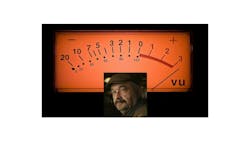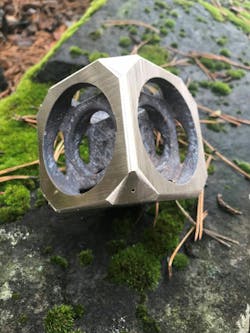Yet Another Blog on Tariffs? You Know Better...
Send wimmin to space
Call them female astronauts
Starve kids who’ll be one
For any of you that have read my bio, you know that one of my many pursuits “after hours” is vehicle electrification, namely EV conversion. In addition to establishing an inventory of key components, like chargers, battery cells, and drive units, I’ve also been acquiring new skills. They include TIG welding of aluminum, MIG welding on steel, and, most recently, metal sculpture in my local community college’s foundry.
In art class, we’ve learned how to create wax patterns, create investment molds, and pour either aluminum or bronze. I’ve been allowed by my instructor to experiment, successfully, with converting a 3D print of my own design in bronze (see figure). My recent two attempts at sand casting have failed, for known reasons, at the sand mold stage so far, though I’m determined to invoke the “Third Time’s a Charm Law of the Universe” this semester.
On the tools side, I’ve acquired a 4-axis CNC VMC (actually 3 axis right now... I’ve needed to repair the Z axis since I got it), a 4-axis “Benchtop” milling machine, a lathe, 65A Hypertherm Plasma cutter, a CNC plasma table for the cutter, a CNC router, and a Miller 280DX TIG welder.
Interesting story on the ‘280DX...it was from a business in Houston that did titanium, aluminum, and alloy weldments for SpaceX, but the 2018 Trump Tariffs on metals created a rise in feedstock prices. That business had to shutter its doors because the added metal costs, sourced from China, could not be passed on to SpaceX. Those Trump tariffs were good for me, as an asset vulture, because that same machine model I learned on at college was about $12k new and getting it for about half the money was painfully close to being within my budget.
I also have about half a megawatt-hour of LG pouch cells (I’d love to give a good home to some more versus having to go to recycling for them) that have aluminum/copper battery tabs on them. My understanding is that industry uses laser or ultrasonic welding on the tabs to build modules from these cells, a task on my short list of getting everything together for my car and truck conversions. I’ve looked into FSW (friction stir welding) on my big milling machine, too, as a possible approach for connecting my cells electrically.
Locked in on Laser-Welding Units
In any case, somewhat unexpectedly, one of my recent scans of Kickstarter projects revealed a sweet-looking laser welding unit, made in China, for about $3k—again about half the going price for the ones I’d seen. Two models were available: a 400-W diode unit and a 900-W fiber laser rig with its core light-engine being sourced from highly regarded Coherent.
The 900-W unit resonated with me, in that it would do the copper and aluminum welding I’d need, even after discounting the specsmanship claims by 50%. The pledge amount included all import tariffs and taxes. So in mid-February, I pledged about $3k for the 900-W machine and its accessories, including shipping and tariffs, with my credit card getting dinged, on March 28, at the end of the successful $5M campaign.
Having pledged back in mid February, and doing an auto-ding on my credit card, all of the Trump rhetoric on tariffs was primarily entertainment for me since then. I watched my colleagues try to catch the falling knife in reporting the latest tariffs news that affected our industry. I steered clear of covering it, since I could not take all the waffling as a negotiation tactic very seriously because it never really affected me...in America, “me” is all that matters.
I pretty much always got circuit boards, components, and other stuff under the $800 tariff de minimis exemption, and my Kickstarter welder’s tariffs were paid by the vendor in China.
“[A] survey of 1,027 U.S. adults taken April 4-6 found 32%, including 19% of Republicans, 49% of Democrats and 30% of independents, incorrectly believe tariffs “are taxes paid by the country exporting the goods.”—April 4-6 Reuters/Ipsos poll
Importer…Exporter…Buyer…Seller…Who’s Who?
Anyone who’s ordered parts or goods knows the exporting country doesn’t pay tariffs. The reality is that it’s the importer that pays the tariffs when the goods enter the destination country—for the sake of perspective, and “how does this affect me?”, the country is USA.
So, here’s the rub. The “importer” can be the seller (in my case with the laser welder terms and conditions), which could be based in China, or the buyer, based in America (me). I was smug, not triggered to do math, until I got a message from the Kickstarter welder campaign folks on April 10, which, in part, said:
“Logistics & Tariff Watch
We've been closely monitoring the evolving U.S. tariff policies and are carefully evaluating how they may impact our overall shipping and logistics costs.***
If the added costs remain manageable, we will absorb them on our end. However, if future policy shifts significantly impact shipping or import duties beyond our capacity, we’ll update you immediately and share any important changes or decisions.”
This was clearly in response to “The White House” announcing a 145% tariff on Chinese goods, covered in this April 10 CNN article. Being an engineer, we prefer math over CYA lawyerwords, so, let’s see:
“Seller agrees to cover tariffs for a laser welder costing $3,000, seller sends a note saying we’ll try to cover if manageable, but those costs are $4,350. Seller takes in $3k, shells out manufacturing costs plus sends Trump, Bezos, Musk, et al $4350 as a tax cut. Seller can’t do this, seller might ship, laser is held hostage by The Administration until I pony up the $4,350, $150 more than the expected cost per household per year...in one purchase.”
Forced to do the math, and not liking either outcome for myself or the seller, I asked for a full refund. The campaign organizers immediately refunded my credit card...they were honorable, perhaps relieved.
This was unlike a Middle Eastern company making a Kickstarter robot chess set in China that I asked a refund from after the welder request, since they haven’t started manufacturing yet, and have been met with total silence. So, I’m out a grand right now on the chess set because they’re adamant about shipping something that I’m expected to pony up another $1,450 to feed Musk, Trump, and Bezos.
Speaking of Bezos. He’s got plenty of dough to cover a doc visit from a faceplant after running a rich-people carnival ride this past week, while Temu and others have been eating Amazon’s lunch on the cheap stuff. The de minimis $800 exclusion has meant consumers can pick up toys, appliances, clothing, etc., for cheap, while Jeff goes hungry cuz he can’t go out for Thai food in his Gulfstream.
So, in the dust stirred up by Trump’s outrageous worldwide tariff policy, intended to act as a national sales tax to cover the $4T shortfall needed to extend the 2017 tax cuts nobody needs, the de minimis tariff exclusion appears to be going away on May 2nd.
Many of us buy our prototype boards and components, etc., from China, including machined pieces. An order from the likes of JLC PCB and others doesn’t have the two- or three-month backlog happening with U.S. houses, so nobody in American manufacturing is going hungry that I can tell. The capacity isn’t there, and most won’t even pick up the phone to talk to a lone wolf engineer about a prototype order.
Now, that $500 batch of boards, or CNC machined cold plate, is going to cost you $1,225. With many of us paying for prototypes out of pocket with after-tax—after $7 bread and $12 eggs—disposable income, many R&D, knowledge-gaining projects get shut down or delayed.
Project Prognosis: DOA?
Not only does this affect the lone wolf, but the tariff uncertainty makes timing of procurement impossible, as it does when putting together a project budget, estimating product pricing/viability, and predicting product run rates. The safest thing to do is not spend, not keep people—"we can do all that a quarter or two later.”
The problem with that is with R&D, a competitive advantage is lost, time to market is lost, and foreign competition is given that dead time to develop IP. I’ve got my basic IP documented with my lawyer, but I need to prototype it to refine it to become usable and valued, much like my other IP. If I don’t fund it until I have the funds or until things settle down, the race to the patent office could be lost.
This is what they don’t get. We’re not only “in pain short term,” but we lose the brand, IP, and R&D race forever because R&D budgets and PR are regarded as discretionary spends, then heads get scratched a few years down the road when the brand/company has vaporized from buyer awareness or from having new product offerings. Nobody wonders or cares about the “why.” They move on to those competitors who address need and cost and who have established mindshare. Smart companies double down on R&D and branding in downturns and only trim manufacturing to meet demand.
All of this turbulence/disruption so that fat cats get a tax cut extension when they’re at record net worth—corporations are flush with cash, and revenues and assets are fully offshored (or are being moved to Texas) out of reach of taxation. Meanwhile, someone in a wheelchair, disabled from birth (now forced in many states) gets cuts to their Social Security and Medicare, an increase in Rx drug prices, and can’t buy eggs or bread with what little they’re already receiving.
If you have a disabled family member, you get tired of the popular media narrative that Social Security and Medicare cuts merely affect old people. Cull the old and the sick is not only cruel, it’s sociopathic.
“In pain for the short term”? In my personal opinion—don’t think so. The 2017 tax cut must go away, tariffs and relationships need a hard reset.
Andy's Nonlinearities blog arrives the first and third Monday of every month. To make sure you don't miss the latest edition, new articles, or breaking news coverage, please subscribe to our Electronic Design Today newsletter. Please also subscribe to Andy’s Automotive Electronics bi-weekly newsletter.
About the Author
Andy Turudic
Technology Editor, Electronic Design
Andy Turudic is a Technology Editor for Electronic Design Magazine, primarily covering Analog and Mixed-Signal circuits and devices. He holds a Bachelor's in EE from the University of Windsor (Ontario Canada) and has been involved in electronics, semiconductors, and gearhead stuff, for a bit over a half century.
"AndyT" brings his multidisciplinary engineering experience from companies that include National Semiconductor (now Texas Instruments), Altera (Intel), Agere, Zarlink, TriQuint,(now Qorvo), SW Bell (managing a research team at Bellcore, Bell Labs and Rockwell Science Center), Bell-Northern Research, and Northern Telecom and brings publisher employment experience as a paperboy for The Oshawa Times.
After hours, when he's not working on the latest invention to add to his portfolio of 16 issued US patents, he's lending advice and experience to the electric vehicle conversion community from his mountain lair in the Pacific Northwet[sic].
AndyT's engineering blog, "Nonlinearities," publishes the 1st and 3rd monday of each month. Andy's OpEd may appear at other times, with fair warning given by the Vu meter pic.


